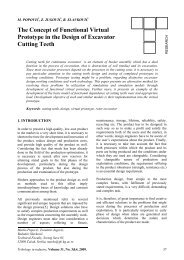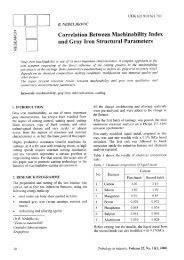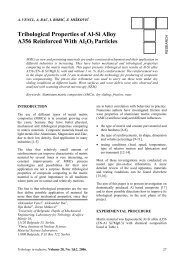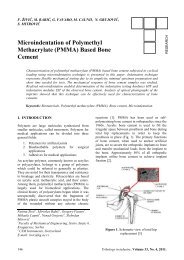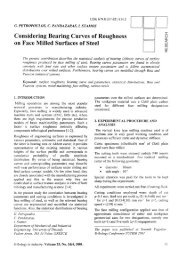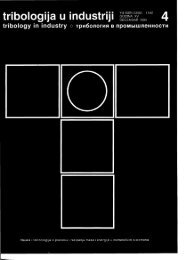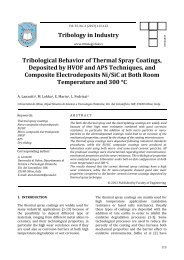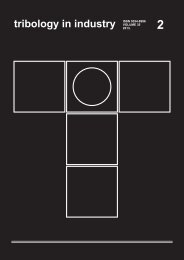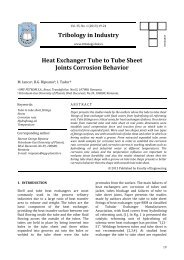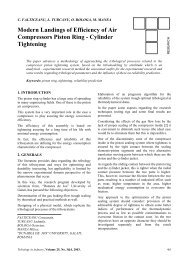No. 4, 1998 - Tribology in Industry
No. 4, 1998 - Tribology in Industry
No. 4, 1998 - Tribology in Industry
You also want an ePaper? Increase the reach of your titles
YUMPU automatically turns print PDFs into web optimized ePapers that Google loves.
Application of trrhology ir-, design and construct<strong>in</strong>g of<br />
technical systems, and ascord<strong>in</strong>gly <strong>in</strong> de'.veloprnent of<br />
mach<strong>in</strong>e systems, wzrs completeiy lagg<strong>in</strong>g beh<strong>in</strong>d the<br />
appiication of otirer technical sciences. Tribological <strong>in</strong>forrnation<br />
were optional for application and use. Constructors<br />
were try<strong>in</strong>g to <strong>in</strong>crease work<strong>in</strong>g reliability and<br />
':i<strong>in</strong>i<strong>in</strong>ate failures, and they considered wear as oae of<br />
cther requiremeirts. For a long time constructors were<br />
calculat<strong>in</strong>g that computation of mach<strong>in</strong>e elements frir<br />
their siatic strength, peimanent strength and stiffness,<br />
can be the necessary warrant of reliable and efficient<br />
operrtion of each mach<strong>in</strong>e. For <strong>in</strong>dividual work<strong>in</strong>g conditrons<br />
of rrachires it was really the like situation. But<br />
tirrr ycars went by. Technical progress persistently required<br />
<strong>in</strong>crease of power, operat<strong>in</strong>g speecis and loads, <strong>in</strong><br />
order to <strong>in</strong>crease.the work<strong>in</strong>g productivity. Mach<strong>in</strong>e ele<strong>in</strong>ents<br />
were operat<strong>in</strong>g <strong>in</strong> more and more severe work<strong>in</strong>g<br />
conditions. At that po<strong>in</strong>t and time distance, the attention<br />
was devoted to causes of failures, and sometimes to<br />
sudden deplet<strong>in</strong>g of thcir projccted work<strong>in</strong>g resources.<br />
More det:iiled analyses have sliown that the most frequent<br />
cause was excessive wear and tribological processes<br />
on vital rnach<strong>in</strong>e elements and assemblies. That was<br />
esoecially obvious <strong>in</strong> oil and gas <strong>in</strong>dustry, m<strong>in</strong><strong>in</strong>g and<br />
agriculturai techniques.<br />
Proirierns of <strong>in</strong>creas<strong>in</strong>g the wear resistance of mach<strong>in</strong>e<br />
elements and assemblie suddenly became actual. That<br />
problem was aga<strong>in</strong> soived by <strong>in</strong>creas<strong>in</strong>S; the strength, In<br />
<strong>in</strong>dividual cases, the problem of <strong>in</strong>creas<strong>in</strong>g the wear<br />
resistance was soived by choos<strong>in</strong>g the steel of higher<br />
hardness. For a long time steel was considered as analogotis<br />
to wear resistance. Later, materialswere substituted<br />
by lubricant, thus the problem of decreas<strong>in</strong>g wear were<br />
for a long time solved by adequate choice of lubricant,<br />
I-ong and difficult penetrat<strong>in</strong>g of tribology <strong>in</strong>to the sciense<br />
of deign and scientific discipl<strong>in</strong>es like: macli<strong>in</strong>e elenrents,<br />
mach<strong>in</strong>c toois, etc., can be expla<strong>in</strong>ed <strong>in</strong> several<br />
wa'r's, and from ciiffereiit po<strong>in</strong>ts of view. The essence of<br />
trrbolcgy, as a uew scientrfic discipl<strong>in</strong>e, is such that form<br />
the beg<strong>in</strong>n<strong>in</strong>g it <strong>in</strong>volved: eng<strong>in</strong>eers, chemists. technologists.<br />
metallurgists, physicists, and others, each frorn<br />
ilieir own aspect. Sueh a rvide ray of possibie <strong>in</strong>terests is,<br />
certii<strong>in</strong>ly, an important ch:rracteristics of tribology, s<strong>in</strong>ce<br />
it is. by its niliilre, <strong>in</strong>terdisc\ll<strong>in</strong>ary. At the same time, just<br />
because i:f that, it was not, for a long tirne, applicable,<br />
:;ree tiie irjomiation of fundamental research could not<br />
sufficientiy satisfy practicai needs of design and construct<strong>in</strong>g.<br />
Another aspect of <strong>in</strong>sufficient application of tribology <strong>in</strong><br />
lnechanicai eng<strong>in</strong>eer<strong>in</strong>g is absence cf coord<strong>in</strong>ation <strong>in</strong><br />
coniiuct<strong>in</strong>g the tribological <strong>in</strong>vestigations, regularly<br />
riann<strong>in</strong>g of publish<strong>in</strong>g the tribological <strong>in</strong>forrnation, notic<strong>in</strong>g<br />
prionf' directicirs, and rrnsl'nchronizedevelopment.<br />
Thus, even tr,-da1', therg exists several versions; of<br />
wear tv,pes classifications, methods of wear tests, wear<br />
evaluations, wear resistance, wear <strong>in</strong>tensity, etc. Certa<strong>in</strong><br />
lack of system <strong>in</strong> development of tribolory as a science<br />
has contributed to the fact that majority of <strong>in</strong>formation<br />
had accidenial character, and was <strong>in</strong> no way related to<br />
practical needs of



